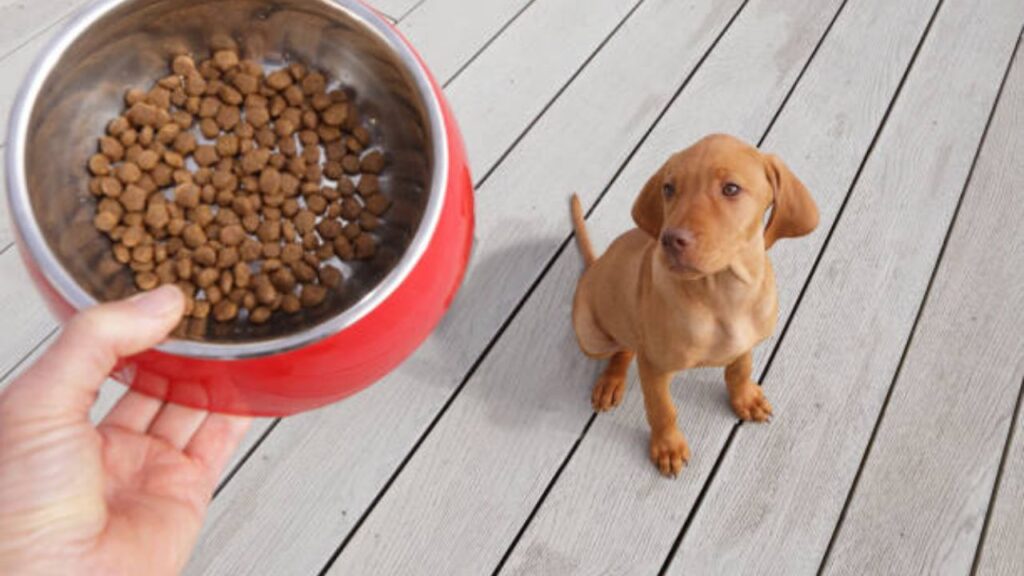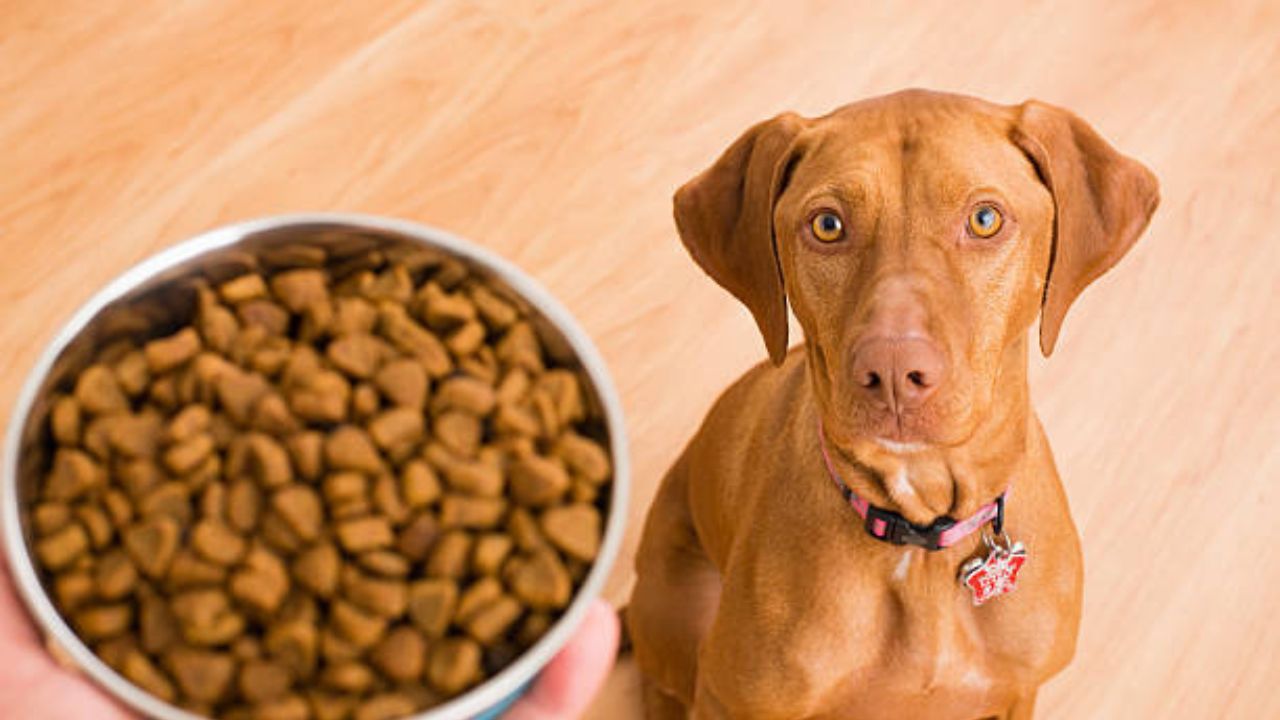Rhodesian ridgeback food are family, not only pets. The food of these strong, athletic canines must change with age if they are to remain healthy. Whether you are keeping a vibrant adult, rearing a fun puppy, or looking after a wise senior, Ridgeback diet is absolutely vital for their health. This book will walk you through how to create meals at every stage of life, address breed-specific issues, and make sure your Ridgeback remains colorful from nose to tail. Let’s arrange the specifics.

Puppy Power: Building a Strong Foundation
Growing quickly, ridgeback puppies can weigh five to ten pounds a month! Their puppy diet must provide fuel for this development without taxing their joints.
- High Protein: 28–32% protein from chicken, lamb, or fish to build muscle.
- Controlled Calcium: Too much can harm developing bones. Look for balanced large-breed puppy formulas.
- Frequent Meals: To prevent bloat, a problem with deep-chested breeds, feed three to four modest amounts daily. Early on refrain from adult dog food as it lacks the necessary nutrients that pups require. Stay with veterinarian advised brands like Purina Pro Plan Large Breed Puppy or Royal Canin Giant Puppy.
Adult Adventures: Fueling Energy and Vitality
Adult Ridgebacks (1–7 years) are in their prime—think hikes, runs, and backyard zoomies. Their diet should match their active lifestyle:
- Moderate Protein: 25–28% to maintain lean muscle (think turkey, beef, or salmon).
- Healthy Fats: Omega-3s from fish oil support joints and glossy coats.
- Fiber: Pumpkin or sweet potatoes aid digestion after scavenging adventures.
Pro Tip: Split meals into two servings (morning/evening) to prevent bloat and keep energy steady
Senior Support: Aging Gracefully with the Right Diet
At 7+ years, Ridgebacks slow down but still need tailored nutrition. Senior dog food should focus on:
- Joint Care: Glucosamine and chondroitin to ease arthritis.
- Lower Calories: Reduce portions slightly to avoid weight gain.
- Easy Digestion: Probiotics and lean proteins like rabbit or venison.
Consider softer textures (wet food or soaked kibble) if dental issues arise. Brands like Hill’s Science Diet Senior Vitality are great options.
Raw Diets for ridgeback food: Pros, Cons, and Safety Tips
Modern but is uncooked feeding (BARF diets) appropriate for Ridgebacks?
- Pros: Shinier coats, cleaner teeth, and natural energy.
- Cons: Risk of bacteria (Salmonella) and unbalanced nutrition.
Safe Raw Feeding: - Use pre-mixed commercial raw meals (e.g., Stella & Chewy’s). Avoid raw pork or fish with bones. Consult a vet to ensure vitamin/mineral balance.

Budget-Friendly Ridgeback Meals Without Sacrificing Quality
Premium dog food can be pricey. Save money without cutting corners:
- Buy in Bulk: Large bags of kibble cost less per pound.
- Homemade Mix-Ins: Add cooked oats, eggs, or veggie scraps to stretch meals.
- Sales & Subscriptions: Sign up for auto-delivery discounts from Chewy or Petc
- Affordable Brands: Less expensive but with quality are Diamond Naturals Large Breeders or Taste of the Wild.
Food Allergies: Spotting Triggers and Finding Solutions
Ridgebacks often develop allergies to common ingredients. Red flags include:
- Itchy skin or hot spots
- Chronic ear infections
- Loose stools
Fix It: - Try limited-ingredient diets (e.g., Zignature Kangaroo).
- Eliminate chicken, beef, or grains for 8 weeks.
- Add quercetin supplements (natural antihistamine).
Hydration Hacks for ridgeback food
These active dogs need water—lots of it.
- Daily Goal: 1 ounce per pound of body weight (e.g., 80 oz for an 80 lb dog).
Encourage Drinking:
- Add low-sodium broth to kibble.
- Use a pet water fountain (they love running water!).
- Offer ice cubes as treats in summer.
Treats That Train and Nourish
Treats aren’t just for bribes! Choose options that add value:
- Training Rewards: Small, low-cal bites like Blue Buffalo Bits.
- Dental Chews: Greenies reduce tartar while satisfying chew urges.
- Homemade: Bake sweet potato slices or dehydrate chicken strips.
Avoid fatty, salty, or sugary snacks—stick to 10% of daily calories.

When to Switch Foods: Signs Your Ridgeback Needs a Change
Sometimes, even great food stops working. Time to switch if you notice:
- Dull coat or excessive shedding
- Weight gain/loss without diet changes
- Low energy or picky eating
Transition slowly over 7–10 days to avoid tummy trouble.
The Role of Supplements in a ridgeback food
Even premium food might miss a few nutrients. Top supplements:
- Fish Oil: Fights inflammation and boosts brain health.
- MSM: Eases joint stiffness.
- Digestive Enzymes: Help seniors absorb nutrients.
Always ask your vet before adding supplements—overdoing it can backfire!
Rhodesian Ridgeback Nutrition: Tailored Diets for Every Life Stage – Quick Comparison
| Life Stage 🐾 | Puppy (8 weeks–1 year) | Adult (1–7 years) | Senior (7+ years) |
| Protein Needs | 28–32% (muscle growth!) | 25–28% (maintenance) | 20–25% (easy on kidneys) |
| Calorie Focus | High (fuel for zoomies) 🔥 | Balanced (active life) | Lower (avoid weight gain) |
| Key Nutrients | Calcium + phosphorus 🦴 | Omega-3s for joints 🌊 | Glucosamine + probiotics |
| Feeding Frequency | 3–4 small meals/day 🍽️ | 2 meals (AM/PM) ⏰ | 2 smaller meals + snacks |
| Budget Hack | Bulk-buy puppy kibble 💸 | Mix in homemade toppers | Senior formulas on sale |
Why Rhodesian ridgeback food Nutrition Can’t Be “One-Size-Fits-All”
Eating a Ridgeback is not like feeding an aquarium fish, let me say that. Depending on the day these dogs are couch potatoes, explorers, and athletes all in one! Their meals must level out as they do for the following reasons:
Growth Spurts vs. Graceful Aging 🐶➡️👵
Puppies grow faster than TikTok trends—skimp on protein or calcium, and you risk joint issues. Seniors, though? They need lighter meals to stay spry without packing on pounds.
Energy Demands Change ⚡➡️🌅
A 2-year-old Ridgeback might hike 10 miles before breakfast. A 9-year-old? Maybe a stroll and a nap. Their food should match their vibe—no one wants a hyper senior or a sluggish pup!
Allergies Sneak Up 🤧
That chicken-and-rice diet they loved at 3 might turn itchy by 5. Switching proteins or trying limited-ingredient foods keeps tails wagging (and skin scratch-free).
Joint Care is Non-Negotiable 🦴
Ridgebacks are prone to hip dysplasia and arthritis. Foods with glucosamine or omega-3s aren’t just “nice-to-have”—they’re armor against aches.
You’re Their Lifelong Chef 👩🍳
Your choices shape their health span, not just lifespan. Good food = fewer vet bills, more park days, and way more belly rubs.
Final Thoughts
Every meal is an opportunity to show your Ridgeback love and care, not only nourishment. Selecting the appropriate Ridgeback diet is about knowing their eccentricities, energy bursts, and even those side-eye glances when supper is late, not only about checking protein levels or calculating calories. Perhaps your dog is a kibble expert with a delicate stomach or maybe they flourish on raw food. Whatever their inclination, your efforts to customize their meals pay off in wagging tails, shiny coats, and those treasured memories when they plunge into adventures with you. A well-fed Ridgeback is not only healthy; they are also content, devoted, and eager to turn every day an adventure. Thus, maintain that bowl full of sweetness, be interested in their requirements, and savor the path of fuelling their greatest life—one mouthful at a time. 🐾❤️.
FAQ’s
1. When should I switch my Ridgeback from puppy to adult food?
Depending on your vet’s recommendation, transition at 12–18 months old. Start gradually over 7–10 days combining adult food with puppy kibble to prevent stomach problems.
2. Are raw diets safe for Ridgebacks?
If done sensibly, they can see your veterinarian to guarantee adequate diet; avoid raw bones; use pre-mixed raw meals from reputable companies.
3. What’s the best budget-friendly food for Ridgebacks?
Check Taste when selecting a Wild or Diamonds Naturals Large Breed. Purchase in bulk; add homemade mix-ins like eggs or vegetables; keep an eye on deals!
4. How do I know if my Ridgeback has food allergies?
Search for diarrhea, ear problems, or itching skin. Try limited-ingredient diets and replace popular proteins—chicken or beef—for new ones like animal or duck.
5. How can I get my Ridgeback to drink more water?
Add low-sodium broth to dishes; utilize a pet fountain—they adore running water! or use ice cubes as summer fare.
